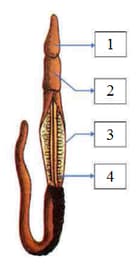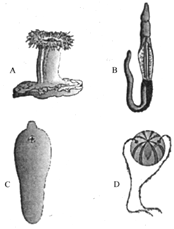Acorn worm lives in a U-shaped Burrow.
Important Questions on Animal Diversity- I (Invertebrate Phyla)
Match the following group of organisms with their respective distinctive characteristics and select the correct option:
| Organisms | Characteristics | ||
| (a) | Platyhelminthes | (i) | Cylindrical body with no segmentation |
| (b) | Echinoderms | (ii) | Warm-blooded animals with direct development |
| (c) | Hemichordates | (iii) | Bilateral symmetry with incomplete digestive system |
| (d) | Aves | (iv) | Radial symmetry with indirect development |
| Column I | Column II | Column III | |||
| a) | Ctenophora | i) | Holothurian | p) | Tornaria |
| b) | Annelida | ii) | Pleurobrachia | q) | Veliger |
| c) | Mollusca | iii) | Balanoglosus | r) | Trochophore |
| d) | Echinodermata | iv) | Aplysia | s) | Cydippid |
| e) | Hemichordate | v) | Nereis | t) | Auricularia |
Label the parts corresponding to the numbers in the diagram given below?

Which among the following is a characteristic of the class Pterobrachia?
Identify the common features of Saccoglossus, Cucumaria and Chaetopleura.
I) Bilaterally symmetrical. They are triploblastic and coelomate animals.
II) Development is indirect.
III) Presence of water vascular system which helps in locomotion.
IV) Excretory system is absent. Sexes are separate.
Examine the figures A, B, C and D. In which one of the four options given, all the items A, B, C and D are correctly identified?

Go through the following diagram -

A - Identify the animal.
B - Name the phylum to which it belongs.

